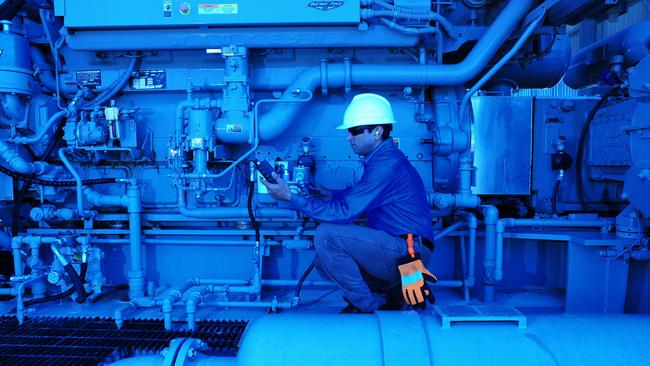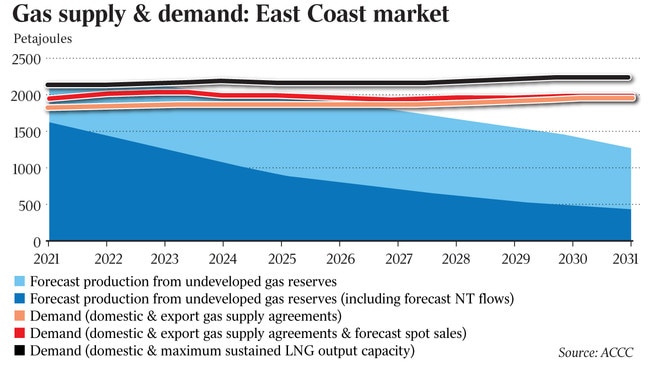Exploration under the gas pump in Victoria
Victoria’s ban on onshore exploration is increasingly growing hard to defend.

As gas emerges as the politically palatable alternative to coal, pressure is building from within the Andrews government to end the five-year moratorium on onshore conventional gas exploration in Victoria. The shift by Labor figures follows mounting pressure from unions, industry and consumers.
It comes after Scott Morrison issued a passionate plea for gas supplies in NSW and Victoria to be unlocked, declaring there is “no credible energy transition plan for an economy like Australia which does not involve greater use of gas as an important transition fuel”.
Australian Competition and Consumer Commission chair Rod Sims has repeatedly called on NSW and Victoria to lift their bans, declaring in August: “If we really want permanently lower prices in the south we need more gas in the south.” Santos’s Narrabri project, with potential to fill half of NSW’s domestic supply, has been a particular bone of contention, with approvals continually delayed by the state.
The federal government is pushing for a national gas reservation policy to improve supplies for manufacturers and heavy industry, along with a price measure to the gas export trigger to ensure the national market is operating efficiently. The Australian Energy Market Operator predicts that offshore gas supplies in Bass Strait are unlikely to meet Victoria’s needs beyond the next five years. AEMO estimated late last year that coal would contribute less than a third of power supply in the grid by 2040 as demand for gas and other renewables surges.
The Morrison government has struck a $2bn deal with the NSW government to pay for carbon abatement and energy projects in return for increased production of natural gas. It says it will not fund a similar deal with Victoria unless the ban on onshore gas exploration is lifted.
With the results of a geological survey of the state’s onshore conventional gas resources expected next month, ahead of the expiration of the moratorium on June 30, energy experts say the Victorian government faces a stark choice: it can either cease being the only state with a ban on conventional gas exploration or import more expensive, less environmentally friendly gas from interstate.
Far from banning conventional gas exploration, Queensland allows all forms of unconventional gas exploration, including fracking, and is home to almost 90 per cent of Australia’s 2P (proven and probable) gas reserves, and about 63 per cent of Australia’s 2C (best estimate of contingent) reserves. NSW permits conventional and unconventional exploration but the Berejiklian government frequently declares it has the “toughest” regulations in Australia, particularly in relation to fracking of coal-seam gas.
Support to lift ban
In 2014, the then O’Farrell government froze new CSG exploration licences and introduced exclusion zones, making residential areas in 152 local government areas of the state, including Sydney, “off limits”. While the freeze has since been lifted, no new licences have been granted.

The West Australian, South Australian and Northern Territory governments have all recently lifted their moratoriums on fracking, except in the southeast of South Australia where it is still prohibited. Tasmania maintains a fracking moratorium but allows conventional and unconventional gas exploration.
While Victorian state Labor MPs remain publicly tight-lipped about which way they are leaning on the conventional gas moratorium, internal sources say there is significant support within the right of the party for its overturning, including from Treasurer Tim Pallas, Resources Minister Jaclyn Symes and key factional powerbroker Adem Somyurek.
Energy and Environment Minister Lily D’Ambrosio — of the Socialist Left faction — has previously supported the moratorium but declined a request from The Australian to clarify her present position.
One source said they would “bet London to a brick” D’Ambrosio would continue to support the moratorium but others said they believed she could be persuaded to support its overturning should more senior members of her faction, including Premier Daniel Andrews, do so. The decision sits within Symes’s resources portfolio.
Australian Workers Union Victorian secretary Ben Davis is one ALP member who has been publicly critical of the moratorium since its inception, saying it is costing jobs. “It sends a terrible investment signal to gas companies and manufacturers alike,” Davis says. “I look forward to the review of the moratorium, and we’ll be campaigning and agitating to get it lifted.”
NSW-based federal opposition resources spokesman Joel Fitzgibbon is another within the Labor camp who does not mince words in calling for the Andrews government to not only lift the moratorium on onshore conventional gas but also overturn its ban on unconventional gas exploration. “Every project, whether it involves fracking or not, should stand on its merits,” Fitzgibbon says. “Blanket bans make no sense.”
While all forms of gas mining involve the extraction of methane from kilometres below the earth’s surface, conventional gas extraction involves releasing gas trapped in sandstone, under solid rock, with minimal impact on the surrounding geology.
Unconventional gas is trapped in a coal seam or shale and is more difficult to extract, often but not always requiring fracking, or fracture stimulation, which involves pumping fluid down the gas well at high pressure to produce small cracks in the target rock reservoir.
Victoria’s moratorium on conventional onshore gas exploration dates back to May 2014, when Napthine government energy minister Russell Northe opted to suspend decisions on all onshore gas exploration in the state until after the November state election, which was won by Labor.

At the time the Coalition feared punishment at the ballot box if it approved a controversial application from Lakes Oil to drill for gas 1500m below Seaspray, in then Nationals leader Peter Ryan’s South Gippsland electorate. Far from lifting the suspension post-election, the new Andrews government maintained it, introducing legislation in 2017 that placed a moratorium on all conventional onshore gas exploration and production until June 30 this year, and permanently banning all unconventional gas mining and exploration, including fracking.
Ahead of the 2018 state election, Andrews went a step further, making a yet-to-be-delivered promise to enshrine a ban on fracking in the state’s constitution. The state Coalition continues to oppose all unconventional gas exploration but this week renewed its calls to lift the moratorium on conventional onshore gas.
Federal Energy Minister Angus Taylor says the “great irony” of Victoria importing increasing amounts of gas from Queensland is that 20 per cent to 40 per cent of Queensland gas is from coal seams.
“That’s exactly what they’re objecting to with their ban on unconventional gas — which they’re not even considering lifting — and yet they’re OK with importing coal-seam gas,” Taylor says.
Anti-fossil fuels groups are ramping up their campaigns ahead of the moratorium expiring. Friends of the Earth campaigns co-ordinator Cam Walker says he is “very concerned” about the possibility of the ban being lifted. “The greatest concern is the climate change implications of the methane that comes from fugitive emissions,” he says. “Looking to mainstream science, it’s clear that we need to stop producing new reserves of fossil fuels if we want to have the hope of keeping temperature rises under 1.5C globally.”
Grattan Institute energy program director Tony Wood says that unless one takes the Friends of The Earth approach of opposing all fossil fuel extraction, there is “no scientific justification” for banning conventional or even all unconventional gas exploration. He concedes lifting the ban on fracking is “too politically sensitive”.
As the June 30 sunset clause on the moratorium approaches, Victorian Lead Scientist Amanda Caples, a stakeholder advisory panel and a team of scientists have been commissioned by the Andrews government to complete a three-year, $40m inquiry into onshore conventional gas as part of the Victorian Gas Program.
One of the key questions they are addressing — which gas companies say they would have answered at no cost to the taxpayer had the moratorium not been imposed — is how much unconventional gas there actually is under Victoria, and therefore what impact it might be able to have in terms of keeping a lid on prices, creating regional jobs and saving manufacturing jobs.
As part of the gas program, scientists from the Victorian Geological Survey are developing comprehensive 3D geological models of the Otway and Gippsland basins, where most of Victoria’s onshore gas is believed to be located. The results of that investigation are expected to be made known next month.
Recent discoveries in the South Australian section of the Otway Basin, near Penola, have encouraged companies with acreages in western Victoria, including Beach Energy, Cooper Energy and Vintage Energy, to hold out hope of finding more gas on the eastern side of the state border.
While the decision on whether to lift the moratorium will be made by the politicians, and not the scientists, The Australian understands the Geological Survey team is working to compile “pre-competitive data” on prospective locations for gas wells.
Should the moratorium be lifted, this would allow the industry some minimal compensation for five years of lost work, in the form of being able to restart ahead of where it was when the moratorium was imposed.
‘Plenty of gas’
The gas program stakeholder advisory panel includes representatives from a wide range of interest groups, including the manufacturing industry, AWU, Victorian Farmers Federation, gas company Beach Energy, the Australian Industry Group, the Great South Coast Group (which represents councils in the Otway Basin, some of which have publicly voiced their support for lifting the moratorium), as well as green groups including Frack Free Moriac and Environment Victoria.
State Resources Minister Jaclyn Symes says the gas program work will “inform decisions about potential onshore gas exploration”. Symes maintains that Australia “has plenty of gas”, blaming escalating prices on an increase in gas exports over the past five years and calling on the federal government to activate its domestic gas security mechanism to put Australian consumers first.
But as AEMO forecasts a 34 per cent decrease in Victorian winter gas production by 2023 because of dwindling supplies in Bass Strait, it is clear the Andrews government is under pressure to increase supply, with new offshore exploration and production licences recently approved at state and commonwealth levels.
The state government, which has jurisdiction to three nautical miles (5.56km) from the coast, recently gave the go-ahead to two onshore-to-offshore wells being drilled by Beach Energy in the Otway Basin.
The wells are permitted under the moratorium, despite beginning on clifftops before extending 1.5km out to sea, kilometres under the earth’s surface.
While Victoria does import some gas via pipelines that connect it to the rest of the east coast gas market, it is a net exporter, with about two-thirds of the gas processed locally being used in the state, and the rest sent to neighbouring states.
If the state cannot produce enough of its own gas in coming years — or refuses to do so by maintaining the moratorium — it will need to import gas, predominantly via a pipeline from southwest Queensland, which AEMO has found would need to be seriously upgraded to carry larger volumes to Victoria.
As the ACCC has highlighted, Queensland gas already costs $2-$4 a gigajoule more than Victorian gas — or up to 50 per cent more.
Australian Petroleum Production and Exploration Association chief executive Andrew McConville says the industry remains hopeful that the Andrews government will “see sense” and lift the moratorium, given Victoria’s longstanding requirement for more natural gas, with 80 per cent of the state’s homes connected to more than 31,000km of gas mains distribution pipelines.
“The Victorian government’s renewable energy target (of 50 per cent by 2030) will also see the demand for natural gas increase,” McConville says.
“Modelling undertaken for the Department of Environment, Land, Water and Planning in 2017 assumes that as other sources of baseload power (coal) no longer become viable they are replaced by natural gas generation capacity.
“Under every scenario modelled for the department, natural gas has a bigger role to play in delivering energy stability to Victoria out to 2050.
“Unless new gas resources in Victoria are developed, families and businesses in the state will pay more than those in states continuing to develop new supply.”




To join the conversation, please log in. Don't have an account? Register
Join the conversation, you are commenting as Logout